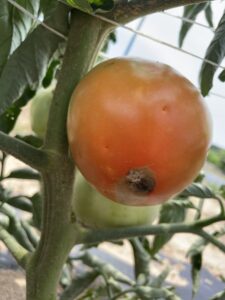After planting on May 16, we only received 1.4 inches of rain in June. The early-setting tomatoes on plants grown on the unirrigated bed had more than 40% fruit blossom end rot (BER) (recorded on June 23). It was 3% on plants grown in a bed that received 17 irrigation events in June and 10% on plants grown in a bed that received 13 irrigation events. We removed all BER fruit on June 27, but more fruit developed BER since then, mainly on the unirrigated bed. We observed BER at every stage of fruit development when the drought continues, from recently setting fruit to fruit turning color (Figure 1).

Figure 1. Tomato fruit shows BER symptoms after it has reached its full size.
A large amount of unmarketable pepper fruit was observed. Surprisingly, all the irrigation treatments had significant numbers of unmarketable fruit, although the bed that was irrigated the most frequently (17 irrigation events in June) had fewer unmarketable peppers than the unirrigated bed and less frequently irrigated bed (13 irrigation events in June). The article ‘Unmarketable Bell Peppers’ discusses the potential factors causing the symptoms.
Cantaloupe harvest started on July 11. More fruit were harvested from irrigated beds than the unirrigated beds. All the ripened cantaloupe fruit are marketable. The first harvest of tomato, pepper and eggplant will also be this week.
From July 7 to July 9, we received 2.91 inches of rain that replenished the unirrigated bed’ soil. Volumetric water content at 12’’ depth on the unirrigated bed raised from around 0.11 to 0.15 (11% to 15%), providing plants with available water in the shallow soils (Figure 2). However, the water may be depleted quickly considering the current water content was only about 60% of water content at field capacity (around 0.25 v/v). Since soil water contents on the irrigated beds at 12’’ depth were close to field capacity before the heavy rainfall occurred, the rain only slightly increased water content at 12’’ depth. Water from the precipitation likely moved to row middles and into deep soils.
More information about this demonstration can be found in the previous newsletter article
Funding for project Improve Drip Irrigation Management for Vegetables and Melon Production in Indiana was made possible by the Indiana State Department of Agriculture through grant A337-22-SCBG-21-003. Its contents are solely the responsibility of the authors and do not necessarily represent the official views of the ISDA.
